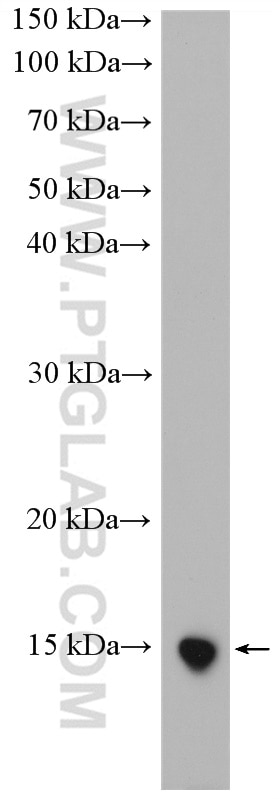Anticorps Polyclonal de lapin anti-UCMA
UCMA Polyclonal Antibody for WB, ELISA
Hôte / Isotype
Lapin / IgG
Réactivité testée
Humain, souris
Applications
WB, ELISA
Conjugaison
Non conjugué
N° de cat : 25503-1-AP
Synonymes
Galerie de données de validation
Applications testées
| Résultats positifs en WB | tissu splénique de souris, |
Dilution recommandée
| Application | Dilution |
|---|---|
| Western Blot (WB) | WB : 1:200-1:1000 |
| It is recommended that this reagent should be titrated in each testing system to obtain optimal results. | |
| Sample-dependent, check data in validation data gallery | |
Informations sur le produit
25503-1-AP cible UCMA dans les applications de WB, ELISA et montre une réactivité avec des échantillons Humain, souris
| Réactivité | Humain, souris |
| Hôte / Isotype | Lapin / IgG |
| Clonalité | Polyclonal |
| Type | Anticorps |
| Immunogène | UCMA Protéine recombinante Ag21985 |
| Nom complet | upper zone of growth plate and cartilage matrix associated |
| Masse moléculaire calculée | 138 aa, 17 kDa |
| Poids moléculaire observé | ~14 kDa |
| Numéro d’acquisition GenBank | BC018068 |
| Symbole du gène | UCMA |
| Identification du gène (NCBI) | 221044 |
| Conjugaison | Non conjugué |
| Forme | Liquide |
| Méthode de purification | Purification par affinité contre l'antigène |
| Tampon de stockage | PBS with 0.02% sodium azide and 50% glycerol |
| Conditions de stockage | Stocker à -20°C. Stable pendant un an après l'expédition. L'aliquotage n'est pas nécessaire pour le stockage à -20oC Les 20ul contiennent 0,1% de BSA. |
Informations générales
UCMA, also named as C10orf49, Ucma-C and GRP, is a 17 kDa small, highly charged, and secreted protein. It has been described as a novel secretory protein mainly expressed in cartilage and also as a novel vitamin-K-dependent protein. UCMA is involved in the negative control of osteogenic differentiation of osteochondrogenic precursor cells in peripheral zones of fetal cartilage and at the cartilage-bone interface.
Protocole
| Product Specific Protocols | |
|---|---|
| WB protocol for UCMA antibody 25503-1-AP | Download protocol |
| Standard Protocols | |
|---|---|
| Click here to view our Standard Protocols |


